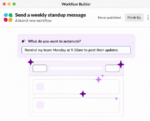The Electronic Frontier Foundation (EFF) is keeping a close eye on artificial intelligence and machine learning, and it wants help from the research community to continue doing so. The organization announced the EFF AI Progress Measurement experiment, which is a pilot project to track the progress happening in the AI field. The EFF encourages researchers to give feedback as well as contribute to the effort.
“There isn’t currently a good single place to find the state of the art on well-specified machine learning metrics, let alone the many problems in artificial intelligence that are still so hard that there are no good datasets and benchmarks to keep track of them yet. So we are trying to make one,” Peter Eckersley, chief computer scientist and Gennie Gebhart, researcher for the EFF, wrote in a post.
The program will collect problems, metrics, data sets and track progress of AI research.
Bugcrowd updates Crowdcontrol
Bugcrowd announced the latest release of its Crowdcontrol platform. The update provides improvements to vulnerability management for the enterprise, and actionable program metrics. Other key features include comprehensive reporting, bi-directional JIRA, Vulnerability Rating Taxonomy data retrieval, and open sourced vulnerability rating taxonomy.
“Today, enterprise security teams are facing more pressure than ever to demonstrate the value of their application security programs,” said Jonathan Cran, vice president of product at Bugcrowd. “At the same time, engineering teams are releasing more quickly than ever. We built Crowdcontrol’s Insights Dashboard with this in mind, providing industry-leading data to track by target, vulnerability type and technical severity to give customers a full picture of their risk profile, while our API and bi-directional JIRA integrations automate workflows to streamline vulnerability remediation.”
Infragistics Ultimate 17.1 released
Infragistics is expanding its UI control suite with new support and capabilities across the application development lifecycle. The latest release lets developers and IT teams gain repeatable and rapid methodology for app modernization across public, private and hybrid clouds.
Key features include: An update to the company’s Ultimate UI for Xamarin with improved performance for native controls, and the Infragistics Xamarin Productivity Pack; enhancements to Ignite UI for JavaScript with the Ignite UI Productivity Pack; advanced filtering, and a new spreadsheet and schedule component; and Indigo Studio, the company’s code-free prototyping and usability testing software.
Redis Labs and Pivotal partner to automate data microservices

Redis Labs announced a new Redis Enterprise Pack for Pivotal Cloud Foundry, which automates management using BOSH, and allows Pivotal Cloud Foundry customers to deploy Redis Enterprise as a data microservice within their platform.
“This is a huge opportunity for enterprises running the Pivotal Cloud Foundry platform to deploy, manage, and scale Redis Enterprise clusters via the Cloud Foundry BOSH interface,” said Yiftach Shoolman, CTO of Redis Labs. “Through this integration, we’re able to support a range of use cases, including high speed transactions, high velocity analytics, job and queue management, fast data ingest, and highly available session store that developers need for next-gen applications.”
The Redis Enterprise Pack with BOSH support lets teams provision a Redis Enterprise cluster, add or remove nodes from the cluster, and easily manage scaling of compute resources. More information can be found here.
Erlang/OTP 20.0 available
Erlang/OTP 20.0 is available for developers that need a complete development environment for concurrent programing. Erlang/OTP is divided into a number of OTP applications, which normally contains Erlang modules. Some OTP applications, according to an Erlang documentation page, are written in other languages and have no Erlang modules.
“When developing with Erlang/OTP you usually test your programs from the interactive shell (see Getting Started With Erlang) where you can call individual functions. There is also a number of tools available, such as the graphical Debugger and the Observer tool for inspection of system information, ets and mnesia tables etc,” reads the document.
Erlang programmers can find more information here.





